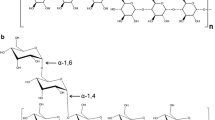Abstract
Pichia membranifaciens strain FY-101, isolated from grape skin, was found to be antagonistic to Botrytis cinerea, the causal organism of the grey mold disease of the grapevine. When grown together on solid as well as in liquid media, the yeast brings about the inhibition of Botrytis cinerea, which in turn loses its ability to produce the grey mold symptoms on the grapevine plantlets. The secretion of β-1,3-glucanases by P. membranifaciens is one of the possible mechanisms related to this antagonism. In vitro experiments confirm that this yeast can be used as a biological control organism against B. cinerea. An account of this antagonism and the production of β-1,3-glucanases by P. membranifaciens is given here.
Similar content being viewed by others
Author information
Authors and Affiliations
Additional information
Received: 16 July 2001 / Accepted: 14 September 2001
Rights and permissions
About this article
Cite this article
Masih, E., Paul, B. Secretion of β-1,3-Glucanases by the Yeast Pichia membranifaciens and Its Possible Role in the Biocontrol of Botrytis cinerea Causing Grey Mold Disease of the Grapevine. Curr Microbiol 44, 391–395 (2002). https://doi.org/10.1007/s00284-001-0011-y
Published:
Issue Date:
DOI: https://doi.org/10.1007/s00284-001-0011-y




